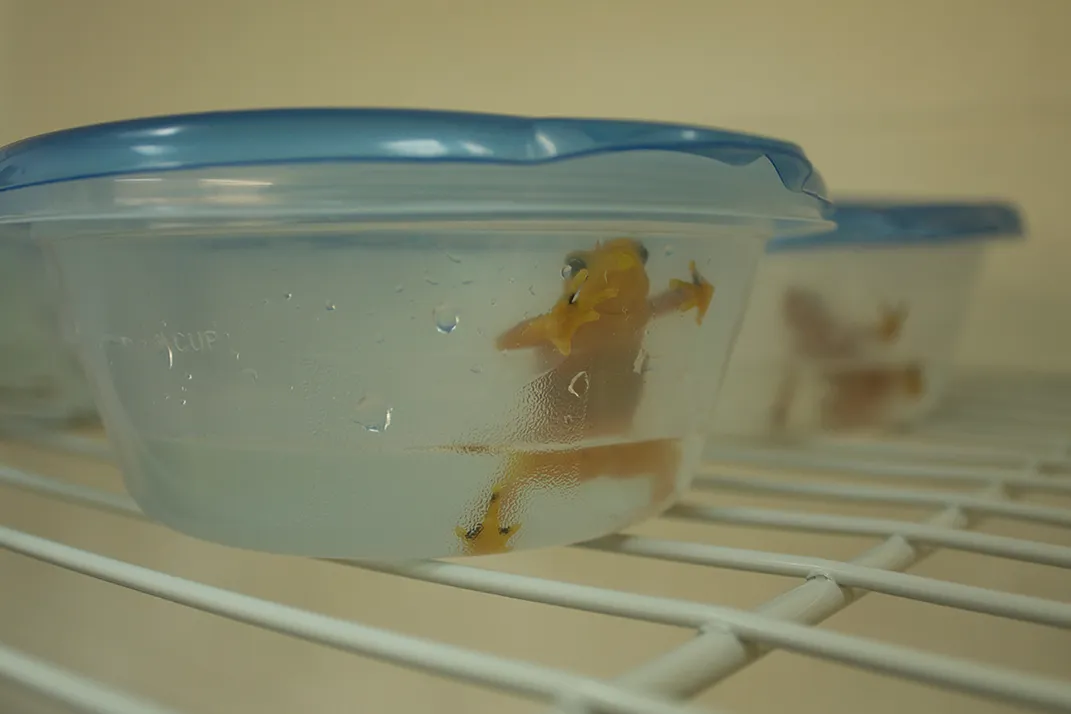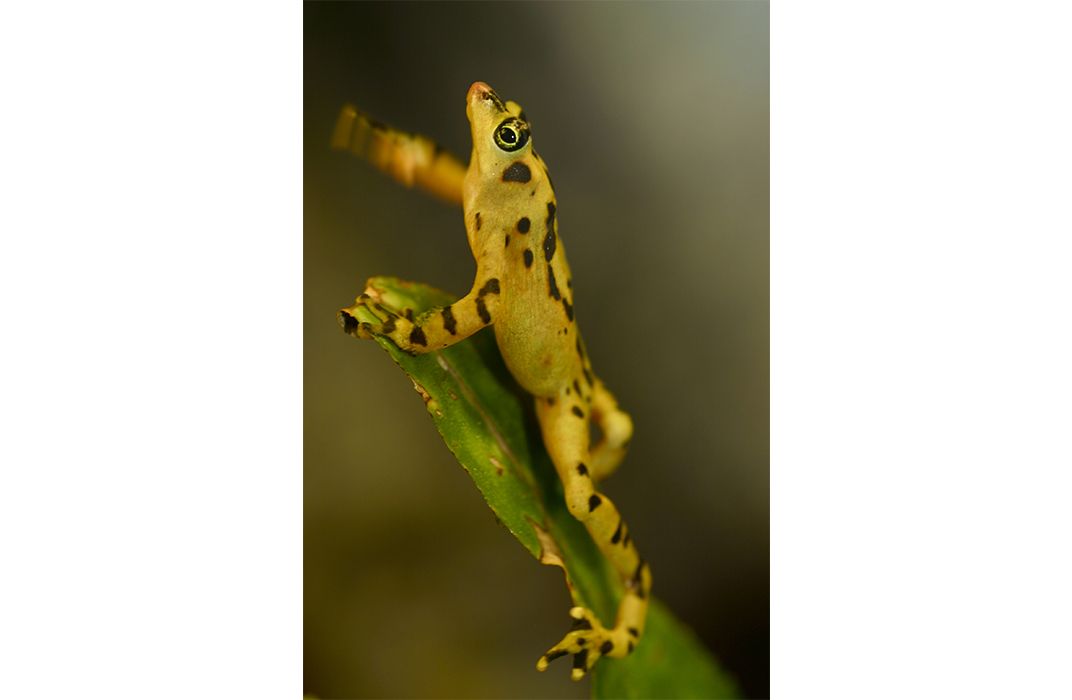The Race to Protect Frogs from a Deadly Pathogen Gets a Much-Needed Boost
A new amphibian lab in Panama will help researchers to return charismatic golden frogs to the wild
/https://tf-cmsv2-smithsonianmag-media.s3.amazonaws.com/filer/25/a9/25a97df2-5599-4699-ba6d-929a189ad5ac/goldenfrogsweb.jpg)
One of the coolest features of the once-abundant Panamanian golden frogs is their wave, says Tulane University professor Cori Richards-Zawacki. It's a behavior that makes them seem almost human. Sitting on the edge of a riverbank these gold and black beauties catch the attention of the opposite sex by raising one arm in a circular motion, and waving at one another.
“My favorite memory was going to the river and eating a sandwich with these frogs,” she says. “They’re the cutest little frogs and they’d sit there, and wave and call. I’d watch them try to jump to a log, and they’d make it halfway there, and wind up in the water, scrambling back to shore. They were so much fun.”
Scientists studying golden frogs today aren’t as fortunate. The last time anyone reported seeing a Panamanian golden frog in the wild was in 2009, after a deadly fungal disease called chytridiomycosis (or chytrid) swept through the Neotropics, wiping out entire amphibian species in its wake.
The devastating pathogen is still in the environment today. And a group of unwaveringly optimistic and impassioned scientists have launched a full-scale investigation into the myriad options for a defense, from the search for a protective shield of bacteria to the quest to understand the genes that could be responsible for resistance—anything that could give golden frogs a leg up. Much of this work is underway in the United States, but a new amphibian lab opens today at the Smithsonian Tropical Research Institute in Panama that will provide researchers coming at this crisis from different angles better access to captive animals and their native habitat.
One of the researchers working feverishly to protect golden frogs is biologist Matt Becker, who got into the golden frog game after the species had gone extinct in its native habitat, so his work has been limited to small groups of golden frogs that come from the 2,000 individuals held in captivity today—a result of happy foresight when scientists collected golden frogs while they were still in the wild and learned to effectively breed them.
Every species—including humans—have beneficial bacteria, or probiotics, on their skin that can protect them from pathogens. This bacteria varies by species and even individuals, and scientists are still not sure what factors determine which bacterial communities individuals wind up with. Becker, however, is on a mission to find the probiotics that will act as an invisible cloak of protection against chytrid for Panamanian golden frogs. If scientists can take that kind of beneficial bacteria from an amphibian species that doesn’t die from chytrid and put it on the golden frog as a shield of sorts, the hypothesis goes, the golden frog might be able to clear an infection.
“The whole point of the research is to figure out how to get these guys back out in the wild,” says Becker, who is a researcher at the Smithsonian Conservation Biology Institute. “Golden frogs are such a cool species to work with, but these aren’t the circumstances you want to be working with them in. We’re more than likely responsible for the spread of chytrid, so I feel like we have an obligation to figure out what we can do about it.”
Researchers believe that the original carrier of chytrid was the African clawed frog, which was used until the 1970s as an indicator of human pregnancy—if a frog laid eggs after a woman’s urine was injected into it, the woman was pregnant. African clawed frogs didn’t die of chytrid; and once released into the wild as carriers, they likely spread it.
Becker’s probiotics work is one possible approach among many that could give golden frogs what they need to survive in the wild. Some researchers are looking at how the genes of individual frogs or the genes of chytrid itself impact whether a frog can successfully fight off the pathogen. Others are trying to innovate through the development of immunizations that could protect frogs. Others still are trying to figure out how to alter amphibian habitat so that the environment warms up slightly—heat, it seems, helps frogs fight the pathogen.
Nature itself seems to be lending an unexpected helpful hand. Richards-Zawacki and fellow researcher Jamie Voyles found a few individual variable harlequin frogs, the sister species to the Panamanian golden frog, living in the wild in places where chytrid is still present. Most recently they discovered a seemingly viable population of about 40 frogs at one site—many of which are infected with chytrid, but not dying as a result. While the pair hasn’t yet found golden frogs in the wild, they aim to understand why a population of the golden frog’s sister species seems to be rebounding, even thriving in every phase of life at this particular site.
“In all likelihood it’s going to be a combination of lots of different angles that result in a workable solution,” says Lisa Belden, associate professor of biological sciences at Virginia Tech and Becker’s PhD advisor. “It’s not just going to be probiotics and it’s not just going to be habitat manipulation. And if we can come up with some possible strategies for golden frogs, it could potentially lead the way for other species.”
The new state-of-the-art $1.2 million amphibian lab at the Gamboa field station, run by the Smithsonian Tropical Research Institute, will help bring together these efforts, facilitating scientists from different disciplines and giving them access to seven Panamanian species considered priority rescue species. For the past five years, the Panama Amphibian Rescue and Conservation Project’s team of Panamanian researchers and conservation biologists have been caretakers to a population of priority amphibian species, all kept in tanks in used shipping containers. Their new lab will have space for five full-time staff members and two visiting researchers, and will include amphibian "rescue pods" for the project’s frogs, many of which are the last individuals of their kind. The pods, constructed from recycled shipping containers, are retrofitted with customized terrariums, or mini-ecosystems, for each frog species.
“Having an in-country facility will open up the doors to many future research projects and to simplify some of the research steps,” says Brian Gratwicke, amphibian conservation biologist for the Smithsonian Conservation Biology Institute and international coordinator for the rescue project. “We’re at a turning point right now and this new facility empowers us to really start the exciting business of figuring out how to get the frogs back into the wild.”
Even if scientists had a silver bullet cure to chytrid today, it would be another four or five years before golden frogs could go back into the wild even as part of a controlled experiment, Gratwicke says. But Gratwicke, says he has no doubt that it is going to happen, that the alternative—that golden frogs don’t return to the wild and chytrid continues to spread—isn’t an option. Like Becker, Richards-Zawacki and countless other amphibian researchers, the return of Panamanian golden frogs is Gratwicke’s primary motive.
“I’ve never seen golden frogs out in the wild,” Gratwicke says. “It gives you a little thrill when you actually see an animal for the first time in its native habitat. You feel just a little jolt. Some people get the thrill of that from money or winning Olympic races or whatever else motivates humans. But that feeling of joy—the joy of seeing a living creature for the first time in its natural habitat—that’s what really motivates me.”
/https://tf-cmsv2-smithsonianmag-media.s3.amazonaws.com/accounts/headshot/57902_434778304825_534194_n.jpg)
/https://tf-cmsv2-smithsonianmag-media.s3.amazonaws.com/filer/18/ec/18ecd6f3-0f14-4b0d-b683-642238c32eb2/4386566461a50d99d390oweb.jpg)
/https://tf-cmsv2-smithsonianmag-media.s3.amazonaws.com/filer/e7/11/e7115ae0-5827-4ab9-9ad3-7f803231123e/6574745961b5fcca8f0doweb.jpg)


/https://tf-cmsv2-smithsonianmag-media.s3.amazonaws.com/filer/b6/90/b690dec4-3c7b-4f3d-81c7-c4e1a228368a/coriandglassfrogeggsweb.jpg)